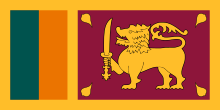Portal:Sri Lanka
The Sri Lanka Portal Sri Lanka, historically known as Ceylon, and officially the Democratic Socialist Republic of Sri Lanka, is an island country in South Asia. It lies in the Indian Ocean, southwest of the Bay of Bengal, separated from the Indian peninsula by the Gulf of Mannar and the Palk Strait. It shares a maritime border with the Maldives in the southwest and India in the northwest. Sri Lanka has a population of approximately 22 million and is home to several cultures, languages and ethnicities. The Sinhalese people form the majority of the population, followed by the Sri Lankan Tamils, who are the largest minority group and are concentrated in northern Sri Lanka; both groups have played an influential role in the island's history. Other long-established groups include the Moors, Indian Tamils, Burghers, Malays, Chinese, and Vedda. Sri Lanka's documented history goes back 3,000 years, with evidence of prehistoric human settlements dating back 125,000 years. The earliest known Buddhist writings of Sri Lanka, known collectively as the Pali Canon, date to the fourth Buddhist council, which took place in 29 BCE. Also called the Pearl of the Indian Ocean, or the Granary of the East, Sri Lanka's geographic location and deep harbours have made it of great strategic importance, from the earliest days of the ancient Silk Road trade route to today's so-called maritime Silk Road. Because its location made it a major trading hub, it was already known to both East Asians and Europeans as long ago as the Anuradhapura period. During a period of great political crisis in the Kingdom of Kotte, the Portuguese arrived in Sri Lanka and sought to control its maritime trade, with a part of Sri Lanka subsequently becoming a Portuguese possession. After the Sinhalese-Portuguese war, the Dutch colonial empire and the Kingdom of Kandy took control of those areas. Dutch Ceylon was taken by the British Empire, which extended control over the whole island, colonising it as British Ceylon from 1815 to 1948. A national movement for political independence arose in the early 20th century, and in 1948, Ceylon became a dominion. It was succeeded by the republic of Sri Lanka in 1972. Sri Lanka's more recent history was marred by the 26-year Sri Lankan Civil War, which began in 1983 and ended in 2009, when the Sri Lanka Armed Forces defeated the Liberation Tigers of Tamil Eelam. (Full article...) Selected article -The Sri Lankan leopard (Panthera pardus kotiya) is a leopard subspecies native to Sri Lanka. It was first described in 1956 by Sri Lankan zoologist Paules Edward Pieris Deraniyagala. Since 2020, the Sri Lankan leopard has been listed as Vulnerable on the IUCN Red List, as the population is estimated at less than 800 mature individuals, and is probably declining. (Full article...)General imagesThe following are images from various Sri Lanka-related articles on Wikipedia.
Related portalsIndian Subcontinent Other countries Selected biography -Samuel James Veluppillai Chelvanayakam MP (Tamil: சாமுவேல் ஜேம்ஸ் வேலுப்பிள்ளை செல்வநாயகம், romanized: Cāmuvēl Jēms Vēluppiḷḷai Celvanāyakam; 31 March 1898 – 26 April 1977) was a Ceylonese lawyer, politician and Member of Parliament. He was the founder and leader of the Illankai Tamil Arasu Kachchi (ITAK) and Tamil United Liberation Front (TULF) and a political leader of the Ceylon Tamil community for more than two decades. Chelvanayakam has been described as a father figure to Ceylon's Tamils, to whom he was known as "Thanthai Chelva" (father Chelva). Born into an expatriate Ceylon Tamil family in Malaya, Chelvanayakam moved to Ceylon while still young. He worked as a teacher before studying law at Ceylon Law College and qualifying as lawyer. A successful career in civil law saw him becoming a King's Counsel and being offered a position on the Supreme Court, which he rejected. As a young lawyer Chelvanayakam was not involved in politics but when the British established the Soulbury Commission to look into constitutional reform in Ceylon he and other Tamil people formed the All Ceylon Tamil Congress (ACTC) to represent Tamil interests. He was elected to Parliament in 1947 to represent Kankesanthurai, a constituency he would represent until his death, except for a period between 1952 and 1956. Chelvanayakam left the ACTC over the party's decision to join the government and in 1949 founded his own party, ITAK, also known as the Federal Party. (Full article...)Did you know (auto-generated)
Selected pictureMore did you know -
TopicsSubcategoriesNew articlesThis list was generated from these rules. Questions and feedback are always welcome! The search is being run daily with the most recent ~14 days of results. Note: Some articles may not be relevant to this project.
Rules | Match log | Results page (for watching) | Last updated: 2024-09-18 22:08 (UTC) Note: The list display can now be customized by each user. See List display personalization for details.
Web resourcesThings you can doWikipedias in Sri Lankan languagesAssociated WikimediaThe following Wikimedia Foundation sister projects provide more on this subject:
Discover Wikipedia using portals |






































































